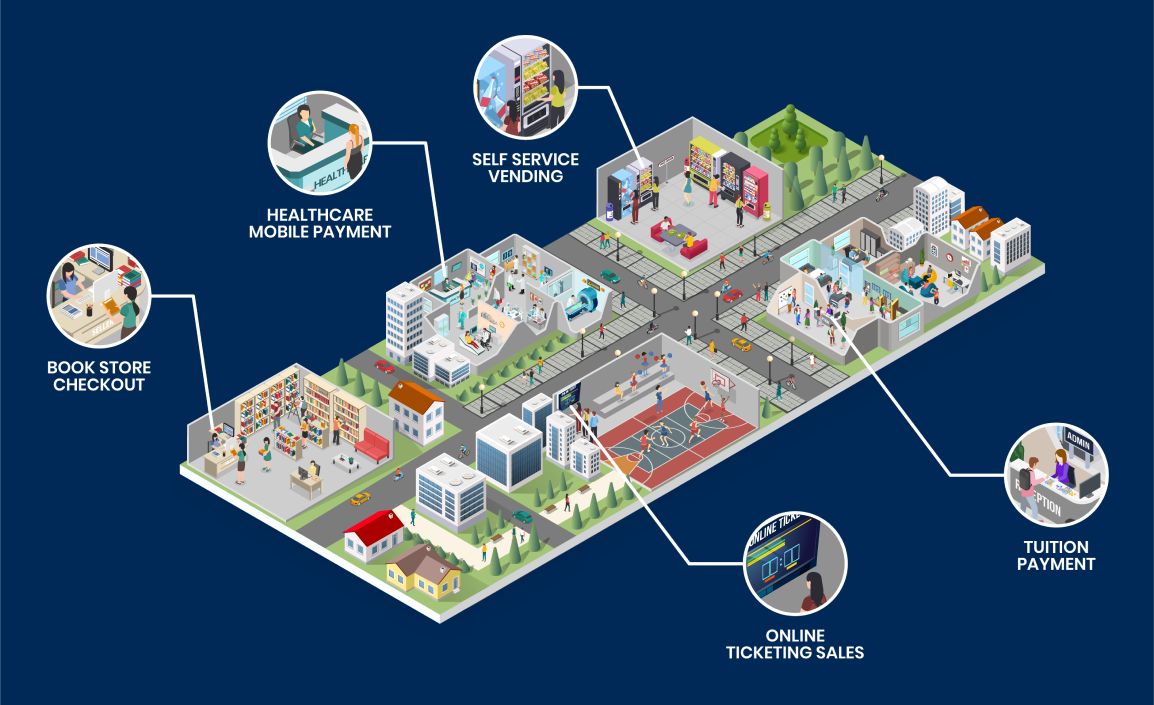Paying for goods, services or bills can take place virtually anywhere today, thanks to the rise in digital payments – a market that exceeded $111B in 2023 and is estimated at $193B by 2028.
Digital payments mean just that – payments done digitally, whether through contactless payment terminals, smart devices, mobile phones or even just a laptop. The increased adoption of smartphones, government initiatives in real-time and P2P payments and greater convenience will continue to propel digital payments.
Fast on the heels of digital payments are embedded payments, where payment processing is literally embedded into software so that it is transparent to the consumers. The payment processor and the software provider are seamlessly blended and become one brand and one experience.
Digital payments are an integral aspect of embedded payments, as the embedded payment offering should be enabled for all digital payment types, across all payment ecosystem touchpoints.
How do embedded payment and digital payments work together across verticals? Today we highlight higher education and the myriad of payment touchpoints in this sophisticated ecosystem.
The College Campus – a City within a City
Colleges and universities are no longer just academic institutions. They have become destinations for sports tournaments, concerts, theater productions, public lectures and more. In fact, 23 universities make at least $125M annually from their sports teams alone.
Some of the largest higher education institutions in the U.S. are mini cities, where students can meet their everyday needs without leaving campus, from meals to shopping to healthcare.
In each location, payments are being accepted. This could be:
- Through a software system that specializes in a certain area of campus, such as ticketing
- As a broader software offering
- As a stand-alone solution provided directly by a payment processor.
“Colleges and universities have more choice than ever when it comes to who they partner with for payments,” said Ruston Miles, Payfactory’s CEO.
“There are more than 400 software providers serving higher education – even if their software wasn’t specifically designed for the HigherEd environment. A great example is healthcare software, which is used in hospitals on campus, or box office platforms that serve the stadium but might also work with theaters on Broadway.
The key is that all of these software vendors are now offering digital payments – online, mobile, NFC – as an embedded solution so that they can not only capture the revenue from their software deployment, but also the revenue from payments.”
When considering an embedded payment strategy, colleges and universities must answer the following:
1. What are the payment touchpoints? In a campus system, this would be the locations where payments are made.
2. How do customers / students like to pay at these touchpoints? There could several ways to pay at one touchpoint, such as a concession stand where a card is dipped or tapped in real-time, or where a mobile order is placed from the stands.
3. What is the best solution to provide these payment types? This will vary based on location. In many cases, one location might be served by one or more software vendors or even payment processors.
The Higher Education Payments Ecosystem
So how do embedded payments work across a campus? It will vary with each location, but in Payfactory’s experience with higher education institutions, some of the most common areas for embedded payments are in:
– The bookstore, where point-of-sale (POS) payment terminals equipped with NFC are common for face-to-face transactions, and mobile / online payments are done for book ordering or store pickup.
– Hospitals or clinics, where mobile payments have become increasingly common, either before, during or after an appointment.
– Self-service vending machines for snacks and supplies, where kiosks and POS payment terminals provide card and digital wallet transactions.
– The Bursar’s Office, where tuition and fee payments can be done within the office or via mobile or online links.
– Ticketing for sporting events, concerts and the theater can be done at the box office but most often are now purchased digitally from a phone, an app or a laptop prior to the event.

Choosing an Embedded Payments Partner – The Payfactory Difference
Payfactory has extensive experience in embedded payments for software companies across a variety of industries, including higher education.
Our CEO, Ruston Miles, has worked on the implementation of payment and security solutions with over 100 colleges and universities in the United States, and has served as a member of the PCI Security Standards Council Board of Advisors since 2019 – pioneering the first PCI-validated point-to-point encryption (P2PE) solution in 2012 as the founder of Bluefin Payment Systems.
Founding Payfactory in 2021, he knew that embedded payment facilitation would drive the future of payments with a seamless implementation and go-live experience for software customers, and little to no development required for software platforms – facilitating a new revenue stream with minimal integration costs.
Combined with our extensive experience, Payfactory is spearheading a new era of payments and security in higher education.
Learn more about Payfactory’s platform or contact us to set up a consultation.
